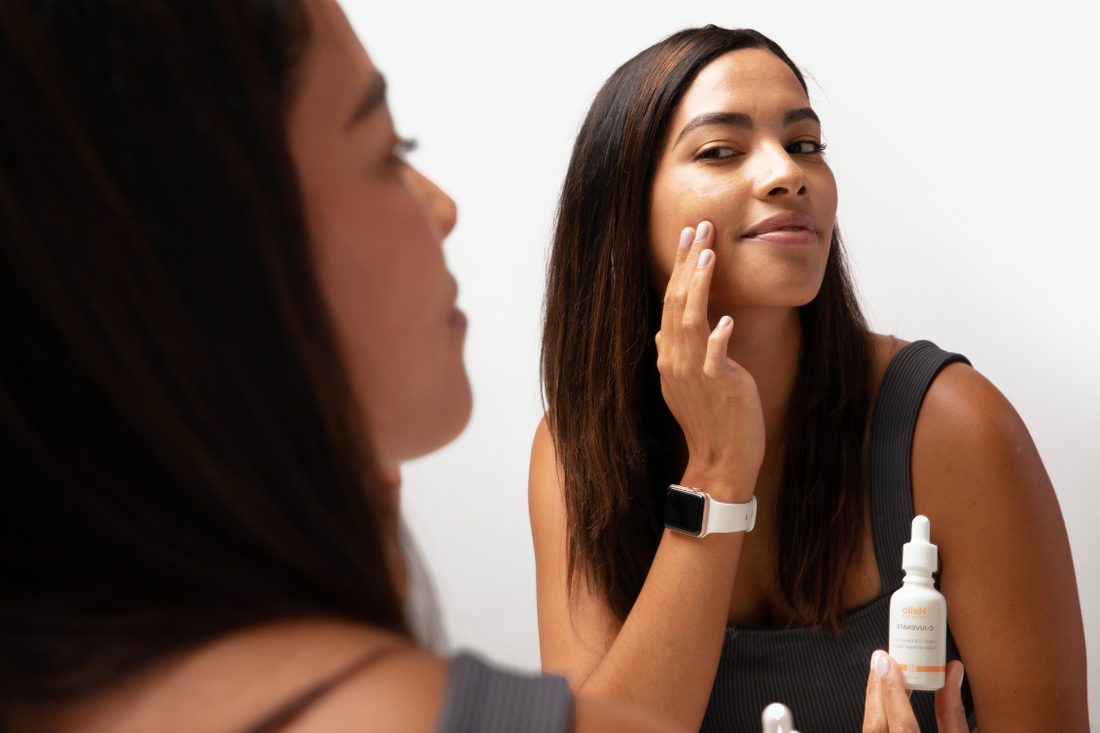Hyaluronic acid is applauded as being the #1 hydrating hero in the skincare industry. Think of it as a “natural Botox in a bottle”! It penetrates the skin and binds water to skin cells, infusing all layers of the skin with valuable, rejuvenating moisture. This may make you want to slather this stuff on, but is there such a thing as too much hyaluronic acid?? How much is too much? Don’t worry gal, we’ve done the research for you!
What is hyaluronic acid?
Hyaluronic acid is a type of sugar our body produces, and 50% of all HA in our body is found in our skin. As we get older, our bodies produce it less frequently - just like collagen (ugh, ikr)! Although nothing can truly slow down the aging process, adding Hyaluronic acid to your skincare routine is the next best thing. HA acts as a humectant, meaning it works like a sponge to attract moisture, keeping your skin hydrated and plump. Additionally, it encourages collagen production and boosts elasticity. HA holds water molecules onto the surface of your skin to keep it supple and hydrated. It can even hold up to 1000 times its weight in water! Woah!

So Hyaluronic Acid is Ultra Hydrating; What other Benefits Does Hyaluronic Acid Have?
So glad you asked! Hyaluronic Acid poses tons of benefits for your skin. HA is anti-aging, moisturizing, wound healing, increases skin elasticity, can treat eczema and redness. It can even help reduce redness and the appearance of acne. The most notable benefit of HA is that its hydrating properties help reduce the appearance of fine lines and wrinkles.
Is there such a thing as too much Hyaluronic Acid? How much is too much?
Yes, there actually is such a thing as too much Hyaluronic Acid. But how can you have too much of this miracle hydrator? Can you really have too much of a good thing? Too much Hyaluronic Acid can dry your skin by drawing moisture from wherever it can, including the deeper layers of your skin. Yikes! You’ll want to avoid products with more than 2 percent HA to avoid irritation or dryness. The sweet spot is actually 0.75 – 1.5 percent. It can be especially drying to use too much HA if you live in a drier climate without a lot of humidity. If there’s no humidity in the air, HA has nowhere else to pull moisture from except your skin! Eek! Too much of a good thing actually can be a bad thing!

What if I have multiple products with hyaluronic acid?
Hyaluronic acid is so popular on the skincare scene that it is commonly used in serums, cleansers, toners and moisturizers. So, it’s not uncommon for you to have multiple products on your bathroom counter that contain hyaluronic acid. Can they be used together or is it too much HA? It is recommended that you primarily stick to one or two hyaluronic acid products in your routine to avoid the “too much” conundrum. Hyaluronic acid is great and it’s no surprise so many products now contain this little wonder, but as mentioned before, too much HA can be damaging. Pick your favorite, most effective HA products and kick the others to the curb. Hyaluronic acid moisturizers and serum tend to be the most effective, especially if the product contains additional moisturizing ingredients. If you’re starting from scratch, both of our super serums, Time Machine and C- Juvenate, contain the hydrating HA.
What ingredients should I look for in my hyaluronic acid serum?
It’s important that your HA serum has complementary ingredients to make sure you’re getting the most out of this hydrating hero. Look for a Hyaluronic Acid serum that contains glycerin and ceramides to prevent dehydration. Other complementary ingredients include vitamin C to help with dryness and protection, and vitamin B5 to soften and smooth skin. Avoid using acids with low PH levels like glycolic acids alongside HA; this could make your HA less effective.
How to Use Hyaluronic Acid
Start with cleansing your face. You’ll want to apply a hyaluronic acid serum while your skin is wet or slightly damp. Never apply HA on to dry skin as the serum will work more effectively when it has moisture to cling to. Complete your routine and follow with a moisturizer and SPF. You can apply Hyaluronic acid every day, morning and night! Wait, I can?! Is twice a day too much? Yes, you can! Twice a day is not too much. The reason being that HA breaks down in the skin after 12 hours. In the AM, HA gives you additional moisture throughout the day, in the evening, HA replenishes moisture lost during the day.
Can you use Hyaluronic Acid and Retinol?
YES! Hyaluronic Acid and Retinol work as a team. Hyaluronic acid can help to prevent retinol irritation. In fact, Retinol, HA, and vitamin C have been boasted as anti-aging superheroes by dermatologists. Plump, glowing skin starts with this timeless trio. Applying HA and vitamin C in the morning will lock in moisture and protect your skin from the environmental elements. HA allows vitamin C to more deeply penetrate skin. Using HA after your retinol night cream will help with the drying effects that are common with retinol. Retinol irritation can cause redness, dryness, and sometimes peeling or flaky skin. HA helps to lessen those side effects. Allow your retinol cream to absorb into your skin for a few minutes before applying hyaluronic acid if possible. Now you can reap the benefits of Retinol, HA and vitamin C without the harsh side effects.
Is Hyaluronic Acid safe for sensitive skin?
Yes, HA is safe for most skin types. On its own, HA tends to not cause allergic reactions or irritation since our bodies naturally produce it. Sure, any name attached to “acid” may sound a bit harsh especially when you’re considering applying it to your skin. HA is actually not an acid in the same way as glycolic acid and salicylic acid. These acids are exfoliating acids and can cause irritation to sensitive skin. HA is technically an acid, but does not have a strongly acidic PH. No worries here! Now get to hydrating!

